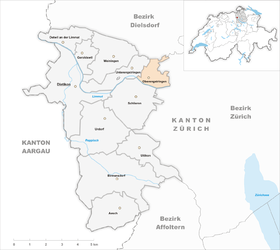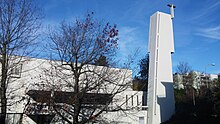Oberengstringen
| Oberengstringen | |
|---|---|
| State : |
|
| Canton : |
|
| District : | Dietikon |
| BFS no. : | 0245 |
| Postal code : | 8102 |
| Coordinates : | 677 358 / 251587 |
| Height : | 413 m above sea level M. |
| Height range : | 390-561 m above sea level M. |
| Area : | 2.15 km² |
| Residents: | 6600 (December 31, 2018) |
| Population density : | 3070 inhabitants per km² |
|
Proportion of foreigners : (residents without citizenship ) |
33.2% (December 31, 2018) |
| Mayor : | André Bender ( SVP ) |
| Website: | www.oberengstringen.ch |
| Location of the municipality | |
Oberengstringen is a municipality in the Dietikon district in the canton of Zurich in Switzerland .
geography
The community is located on the outskirts of Zurich , on the right of the Limmat . Oberengstringen is located on the city limits of Zurich, more precisely the district of Höngg . 23.5% of the municipal area is used for agriculture, 25.8% is covered with forest, 8.9% is traffic area and 39.0% is settlement area, 2.8% is water.
history

The name Enstelingen is mentioned for the first time in a deed of donation in 870 . Landeloh, a descendant of the Alemannic prehistoric nobility and owner of rich estates in Zurichgau, donated his own church to Hoinga ( Höngg ) along with many goods on the right side of the Limmattal to the monastery of Sankt Gallen . At the same time, Landeloh received these goods, increased by Sanktgallic fiefs , including a Hube (farm) in Enstelingen (Engstringen), for lifelong usufruct. The place name Lanzrain (= Landelohs Rain) still reminds of these Alemannic descendants.
In the High Middle Ages, most of today's municipal area was owned by the Regensbergers . In addition, the Counts of Rapperswil , the Barons of Wasserstelz and the Habsburgs temporarily owned some goods. Since then, there has been a division into Ober- and Unterengstringen . When the Regensbergers became impoverished because of their lush lifestyle and ongoing feuds, their property in Oberengstringen passed piece by piece to the Fahr and Wettingen monasteries in the 14th century . The bailiwick rights were granted to citizens of Zurich by the abbot of Einsiedeln (to which the Fahr Monastery still belongs to this day), while the high or blood jurisdiction remained in the hands of the county of Baden .
In 1435 the rights of the Weiningen jurisdiction came to the Meyer von Knonau family from Zurich, who exercised these rights for centuries and only had to renounce them in 1798 when the Old Confederation fell . In 1798 a freedom tree was planted on the village square and the community was recognized as a fully authorized Zurich location. The liberal era in the 19th century brought Oberengstringen its first industry. In place of the Lanzenrain mill , which probably came from the earliest times, the Bebiésche cotton factory was built, which employed up to 60 workers for decades. This factory also built the food house that still exists today . When this first factory on Oberengstringer Grund had to cease operations, the houses were mainly inhabited by workers who were employed in Schlieren. In the 19th century the population of Oberengstringen rose to 400 people.
The development of Oberengstringen was hampered well into the 20th century, as the village was cut off from the development of traffic in the Limmattal: the Spanish-Brötli-Bahn was built on the left side of the Limmattal, and the Limmattal tram ran from Zurich via Schlieren and Unterengstringen to Weiningen , did not affect the municipality of Oberengstringen. The incorporation of Höngg into Zurich in 1934 made Oberengstringen a direct neighbor of the city, which was one of the reasons for the construction boom and the rapid development of Oberengstringen from a rural village to an agglomeration community. Since the infrastructures of the former village had become too small for the increased population, these were built in a short time in the second half of the 20th century, including the parish hall, the churches of the Reformed and Catholic regional churches, but also shops, schoolhouses and a own cemetery.
coat of arms
- In blue a silver pruning knife with a golden handle turned to the left in front of a silver ploughshare.
The oldest representation of the municipal coat of arms of Oberengstringen is from 1792 on a bucket of the fire brigade, which is however no longer in the possession of the fire brigade.
politics
The SVP has 15.5 percent, the SP 21.0 percent, the FDP 18.1 percent, the Greens 5.5 percent, the CVP 8.5 percent and the EPP 2.2 percent of the vote.
Churches
When Engstringen was first mentioned in a document in 870, there was already a small field chapel in the municipality, which was consecrated to Saint Verena . Here were measuring read and funerals held, but she was from the parish church Höngg care of. The church was supervised by the Bishop of Constance . After the Reformation in 1523, the Verena chapel in Engstringen was profaned and then used as a residential building and warehouse until it was finally demolished in 1897. The Reformed and later also the Catholic parish of Höngg remained responsible for pastoral care in Oberengstringen into the 20th century.
Today there are two churches in Oberengstringen:
- The Reformed regional church owns the Reformed Church Oberengstringen in the village center , which was built in 1984. The church interior is on the upper floor of the building and has an artistically designed wooden ceiling. Next to it is the Reformed parish hall, built in 1951, whose hall was also used as a church service room until the present church was built. The separation of Oberengstringen from the Reformed parish of Höngg took place on January 1, 1977.
- The Roman Catholic Church is represented in Oberengstringen with the parish of St. Mauritius . The Catholic parish of Oberengstringen, like the Reformed parish, did not come into being until the second half of the 20th century and was previously also part of the church structures of Zurich-Höngg. The parish is named after St. Mauritius because the church in Höngg was dedicated to this saint until the Reformation. Between 1961 and 1962, the architect Fritz Metzger built the church on Zürichstrasse, including the parish center and parsonage. In 1963 the parish of St. Mauritius was founded and separated from the parish of the Holy Spirit in Zurich-Höngg. The Catholic parish of Oberengstringen also looks after the Catholics in Unterengstringen.
Attractions
school
Oberengstringen has three school buildings. These are the commons, the Rebberg-Gubrist and the GSH (Goldschmied-Halde-Sunnerain). In the meantime there were plans to build a very large school center. They were rejected again. The upper level is located in the largest school building (Allmend). The lower and middle grades are housed in the other two school units.
The current school president is Elsbeth von Atzigen.
literature
- Karl Grunder: The Art Monuments of the Canton of Zurich Volume 9: The Dietikon District. Edited by the Society for Swiss Art History GSK. Bern 1997 (Art Monuments of Switzerland Volume 88). ISBN 3-909164-57-9 . Pp. 151-169.
Web links
- Official website of the municipality of Oberengstringen
- Martin Illi: Oberengstringen. In: Historical Lexicon of Switzerland .
- Statistical data for the municipality of Oberengstringen
Individual evidence
- ↑ Permanent and non-permanent resident population by year, canton, district, municipality, population type and gender (permanent resident population). In: bfs. admin.ch . Federal Statistical Office (FSO), August 31, 2019, accessed on December 22, 2019 .
- ↑ Data on the resident population by home, gender and age (community profile). Statistical Office of the Canton of Zurich, accessed on December 22, 2019 .
- ^ Website of the municipality of Oberengstringen, section history. Retrieved November 10, 2013.
- ↑ http://www.oberengstringen.ch/de/portrait/geschichte/welcome.php?action=showinfo&info_id=1125
- ^ Website of the municipality of Oberengstringen, section history. Retrieved November 9, 2013.
- ^ Website of the reformed parish of Oberengstringen, section About us. Retrieved November 10, 2013.




